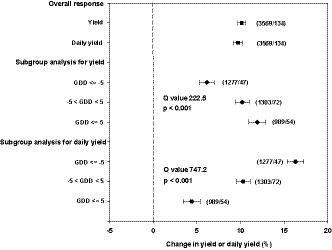当前位置:
X-MOL 学术
›
Food Energy Secur.
›
论文详情
Our official English website, www.x-mol.net, welcomes your
feedback! (Note: you will need to create a separate account there.)
High yields of hybrid rice do not require more nitrogen fertilizer than inbred rice: A meta‐analysis
Food and Energy Security ( IF 4.0 ) Pub Date : 2021-02-03 , DOI: 10.1002/fes3.276 Le Xu 1 , Shen Yuan 1 , Xinyu Wang 1 , Xing Yu 1 , Shaobing Peng 1
Food and Energy Security ( IF 4.0 ) Pub Date : 2021-02-03 , DOI: 10.1002/fes3.276 Le Xu 1 , Shen Yuan 1 , Xinyu Wang 1 , Xing Yu 1 , Shaobing Peng 1
Affiliation

|
Hybrid rice has been planted throughout China to ensure food security owing to its higher yield potential than inbred rice. Meanwhile, substantial nitrogen (N) fertilizer has been applied to feed hybrid varieties for maximizing grain yield. However, to what extent the higher yield of hybrid than inbred rice depends on N fertilizer input remains unclear. A meta‐analysis was conducted in this study to (1) quantify the difference in N uptake and utilization between hybrid and inbred rice; (2) determine whether hybrid rice requires more N than inbred rice for producing per unit grain yield; and (3) evaluate the impact of the difference in crop growth duration between hybrid and inbred rice on their yield performance. The results showed that, overall, hybrid rice achieved a 10.1% higher grain yield, and 9.7% higher daily grain yield than inbred rice. This grain yield advantage increased from 6.1% to 11.9% depending on whether hybrids have longer crop growth duration than inbred rice. The yield advantage of hybrid rice was explained by higher total N uptake and internal N use efficiency, but not explained by N fertilizer input. Moreover, the yield advantage of hybrid rice with N fertilizer was driven by higher yield without N fertilizer instead of yield response to N fertilizer. These results suggest that hybrid rice does not necessarily require more N fertilizer to achieve higher yield than inbred rice. Therefore, hybrid rice could be planted with fewer external N to ensure food security and reduce environmental costs.
中文翻译:

杂交水稻的高产比自交水稻不需要更多的氮肥:荟萃分析
由于杂交水稻的产量潜力远高于自交水稻,因此已在全国各地种植杂交水稻,以确保粮食安全。同时,大量的氮肥已被用于饲喂杂交品种,以最大程度地提高谷物产量。但是,杂交稻比自交稻更高的产量在何种程度上取决于氮肥的投入尚不清楚。这项研究进行了荟萃分析,以(1)量化杂交稻和自交稻之间氮素吸收和利用的差异;(2)确定杂交水稻每单位产量要比自交水稻需要更多的氮;(3)评估杂交稻和自交稻之间的作物生长持续时间差异对其产量表现的影响。结果表明,总的来说,杂交稻比自交稻高出10.1%,日粮高9.7%。取决于杂交种是否比自交水稻具有更长的作物生长持续时间,这种谷物的单产优势将从6.1%增至11.9%。杂交水稻的产量优势可以通过较高的总氮吸收量和内部氮素利用效率来解释,而不能通过氮肥的投入来解释。此外,不使用氮肥而不是对氮肥的增产反应,是由于使用氮肥的杂交水稻的产量优势是由较高的产量驱动的。这些结果表明,杂交稻与自交稻相比并不一定需要更多的氮肥来获得更高的产量。因此,杂交水稻可以种植较少的外部氮,以确保粮食安全并降低环境成本。杂交水稻的产量优势可以通过较高的总氮吸收量和内部氮素利用效率来解释,而不能通过氮肥的投入来解释。此外,不使用氮肥而不是对氮肥的增产反应,是由于使用氮肥的杂交水稻的产量优势是由较高的产量驱动的。这些结果表明,杂交稻与自交稻相比并不一定需要更多的氮肥来获得更高的产量。因此,杂交水稻可以种植较少的外部氮,以确保粮食安全并降低环境成本。杂交水稻的产量优势可以通过较高的总氮吸收量和内部氮素利用效率来解释,而不能通过氮肥的投入来解释。此外,不使用氮肥而不是对氮肥的增产反应,是由于使用氮肥的杂交水稻的产量优势是由较高的产量驱动的。这些结果表明,杂交稻与自交稻相比并不一定需要更多的氮肥来获得更高的产量。因此,杂交水稻可以种植较少的外部氮,以确保粮食安全并降低环境成本。这些结果表明,杂交稻与自交稻相比并不一定需要更多的氮肥来获得更高的产量。因此,杂交水稻可以种植较少的外部氮,以确保粮食安全并降低环境成本。这些结果表明,杂交稻与自交稻相比并不一定需要更多的氮肥来获得更高的产量。因此,杂交水稻可以种植较少的外部氮,以确保粮食安全并降低环境成本。
更新日期:2021-02-03
中文翻译:

杂交水稻的高产比自交水稻不需要更多的氮肥:荟萃分析
由于杂交水稻的产量潜力远高于自交水稻,因此已在全国各地种植杂交水稻,以确保粮食安全。同时,大量的氮肥已被用于饲喂杂交品种,以最大程度地提高谷物产量。但是,杂交稻比自交稻更高的产量在何种程度上取决于氮肥的投入尚不清楚。这项研究进行了荟萃分析,以(1)量化杂交稻和自交稻之间氮素吸收和利用的差异;(2)确定杂交水稻每单位产量要比自交水稻需要更多的氮;(3)评估杂交稻和自交稻之间的作物生长持续时间差异对其产量表现的影响。结果表明,总的来说,杂交稻比自交稻高出10.1%,日粮高9.7%。取决于杂交种是否比自交水稻具有更长的作物生长持续时间,这种谷物的单产优势将从6.1%增至11.9%。杂交水稻的产量优势可以通过较高的总氮吸收量和内部氮素利用效率来解释,而不能通过氮肥的投入来解释。此外,不使用氮肥而不是对氮肥的增产反应,是由于使用氮肥的杂交水稻的产量优势是由较高的产量驱动的。这些结果表明,杂交稻与自交稻相比并不一定需要更多的氮肥来获得更高的产量。因此,杂交水稻可以种植较少的外部氮,以确保粮食安全并降低环境成本。杂交水稻的产量优势可以通过较高的总氮吸收量和内部氮素利用效率来解释,而不能通过氮肥的投入来解释。此外,不使用氮肥而不是对氮肥的增产反应,是由于使用氮肥的杂交水稻的产量优势是由较高的产量驱动的。这些结果表明,杂交稻与自交稻相比并不一定需要更多的氮肥来获得更高的产量。因此,杂交水稻可以种植较少的外部氮,以确保粮食安全并降低环境成本。杂交水稻的产量优势可以通过较高的总氮吸收量和内部氮素利用效率来解释,而不能通过氮肥的投入来解释。此外,不使用氮肥而不是对氮肥的增产反应,是由于使用氮肥的杂交水稻的产量优势是由较高的产量驱动的。这些结果表明,杂交稻与自交稻相比并不一定需要更多的氮肥来获得更高的产量。因此,杂交水稻可以种植较少的外部氮,以确保粮食安全并降低环境成本。这些结果表明,杂交稻与自交稻相比并不一定需要更多的氮肥来获得更高的产量。因此,杂交水稻可以种植较少的外部氮,以确保粮食安全并降低环境成本。这些结果表明,杂交稻与自交稻相比并不一定需要更多的氮肥来获得更高的产量。因此,杂交水稻可以种植较少的外部氮,以确保粮食安全并降低环境成本。










































 京公网安备 11010802027423号
京公网安备 11010802027423号